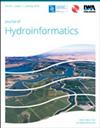Modeling of truncated normal distribution for estimating hydraulic parameters in water distribution systems: taking nodal water demand as an example
IF 2.2
3区 工程技术
Q3 COMPUTER SCIENCE, INTERDISCIPLINARY APPLICATIONS
引用次数: 0
Abstract
Abstract The normal probability density function (PDF) is widely used in parameter estimation in the modeling of dynamic systems, assuming that the random variables are distributed at infinite intervals. However, in practice, these random variables are usually distributed in a finite region confined by the physical process and engineering practice. In this study, we address this issue through the application of truncated normal PDF. This method avoids a non-differentiable problem inherited in the truncated normal PDF at the truncation points, a limitation that can limit the use of analytical methods (e.g., Gaussian approximation). A data assimilation method with the derived formula is proposed to describe the probability of parameter and measurement noise in the truncated space. In application to a water distribution system (WDS), the proposed method leads to estimating nodal water demand and hydraulic pressure key to hydraulic and water quality model simulations. Application results to a hypothetical and a large field WDS clearly show the superiority of the proposed method in parameter estimation for WDS simulations. This improvement is essential for developing real-time hydraulic and water quality simulation and process control in field applications when the parameter and measurement noise are distributed in the finite region.配水系统水力参数估计的截断正态分布建模——以节点需水量为例
摘要正态概率密度函数(PDF)被广泛用于动态系统建模中的参数估计,它假设随机变量在无限区间内分布。然而,在实际应用中,这些随机变量通常受物理过程和工程实践的限制而分布在有限的区域内。在本研究中,我们通过应用截断的正常PDF来解决这个问题。该方法避免了截断的正态PDF在截断点处继承的不可微问题,这一限制可能限制解析方法(例如高斯近似)的使用。利用导出的公式,提出了一种数据同化方法来描述截断空间中参数噪声和测量噪声的概率。将该方法应用于配水系统(WDS),得到了节点需水量和水力压力的估计,这是水力和水质模型仿真的关键。对一个假设的大视场WDS的应用结果清楚地表明了该方法在WDS仿真参数估计方面的优越性。当参数和测量噪声分布在有限区域时,这种改进对于开发现场应用中的实时水力和水质模拟和过程控制至关重要。
本文章由计算机程序翻译,如有差异,请以英文原文为准。
求助全文
约1分钟内获得全文
求助全文
来源期刊

Journal of Hydroinformatics
工程技术-工程:土木
CiteScore
4.80
自引率
3.70%
发文量
59
审稿时长
3 months
期刊介绍:
Journal of Hydroinformatics is a peer-reviewed journal devoted to the application of information technology in the widest sense to problems of the aquatic environment. It promotes Hydroinformatics as a cross-disciplinary field of study, combining technological, human-sociological and more general environmental interests, including an ethical perspective.
 求助内容:
求助内容: 应助结果提醒方式:
应助结果提醒方式:


